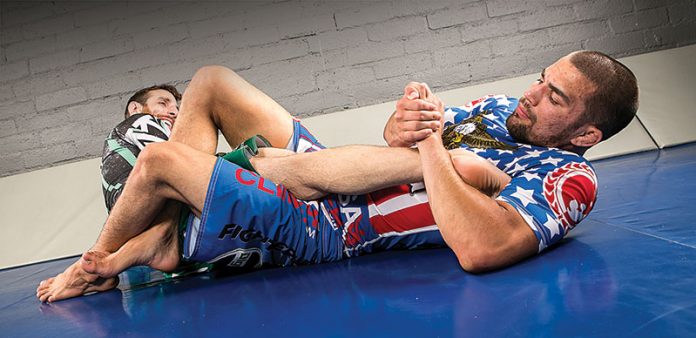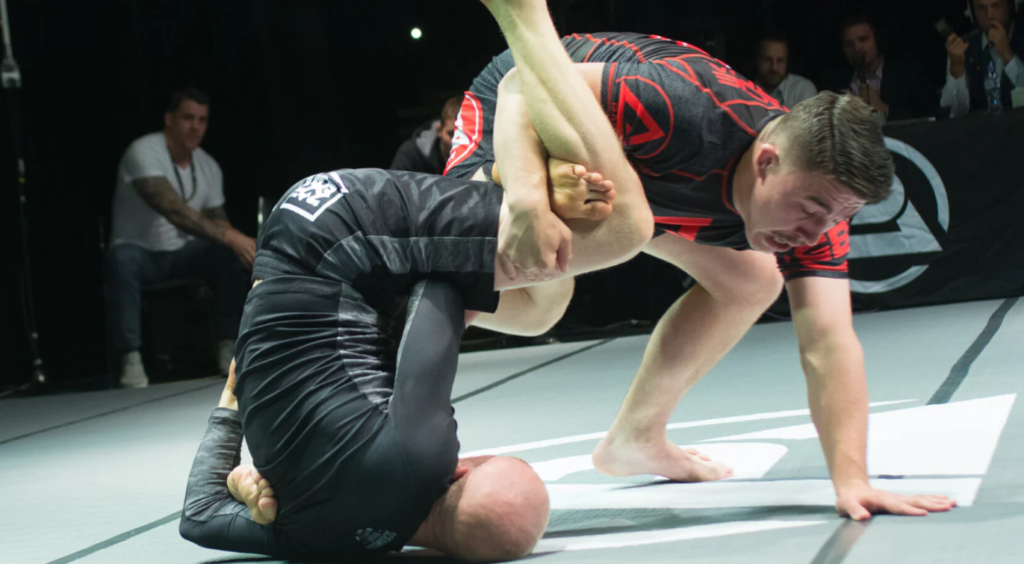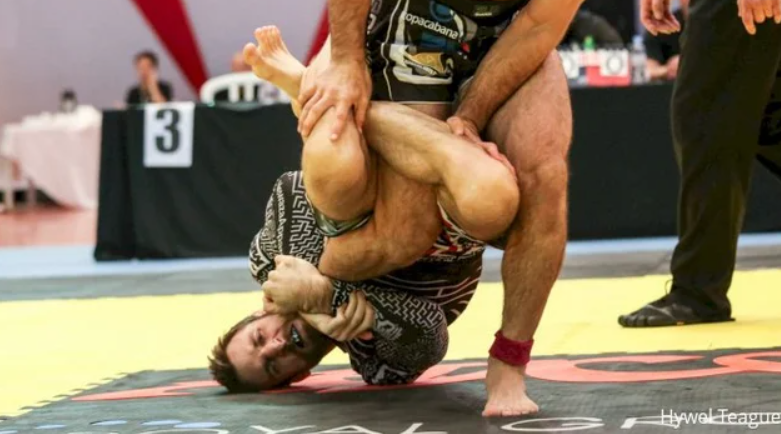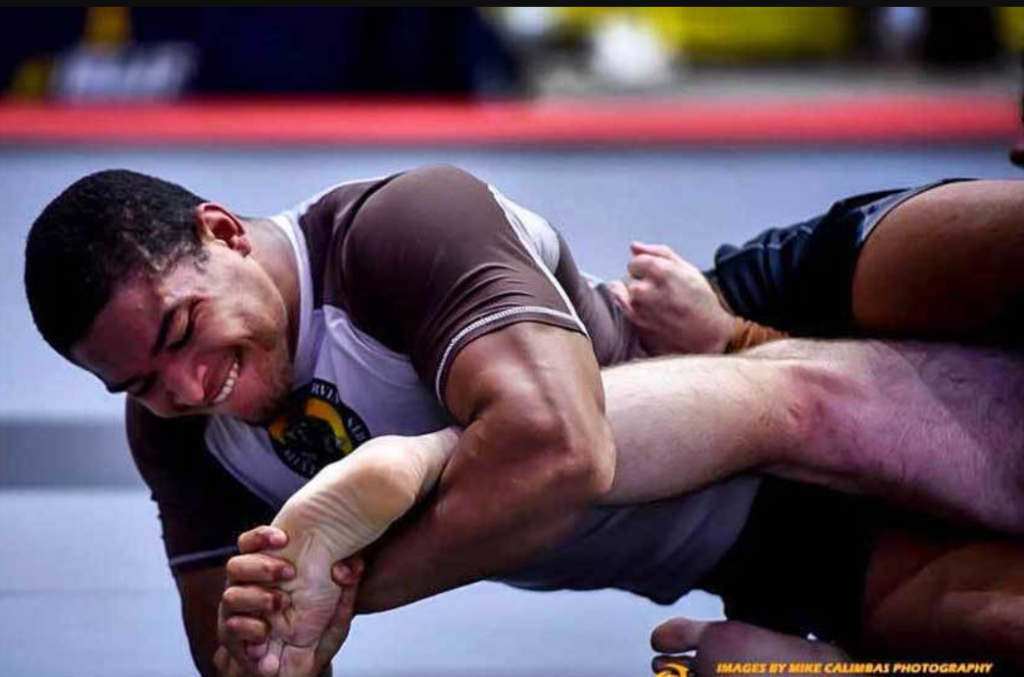
Let’s get the obvious out of the way straight off the bat. John Danaher is arguably the best leg locks coach in the world. His Danaher Death Squad is the most fearsome group of lower limb submission artists on the No-Gi scene. Okay, now that we stated the obvious, let’s look at what matters. Leg locks are definitely powerful submissions, but they’re no longer the one submission to rule them all. As people wise up to them, there are certain patterns that start appearing. When people follow these patterns, they start to understand the leg lock game.
Leg locks remain controversial and complex. They have a long history and culture in grappling arts, and they have evolved and changed over time. They have different rules and legality depending on your belt level, the type of competition, and the organization. Furthermore, there are different risks and benefits depending on how you use them and how you train them.
By the end of this article, you will have a comprehensive understanding of the leg lock game in BJJ, and you will be able to use it to your advantage in training and competition.
What Are Leg Locks?
Leg locks are a form of submission that is directed at the joints and muscles of the lower body (hips and below), with the goal of causing enough pain and/or damage for the opponent to not be able to continue the match. The ankles and knees are common targets of a leg lock submission.
Leg locks work by applying leverage and pressure on the opponent’s leg joints in breaking or rotational force. This means that you use your arms, legs, or body to create a fulcrum (a point where force is applied) on the opponent’s leg joint, and then apply force in a direction that goes beyond the normal range of motion of that joint. This causes pain by stretching or tearing the ligaments, tendons, or cartilage that support the joint. In some cases, it can also cause damage by dislocating or fracturing the bones.
There are two main categories of leg locks: joint locks and compression locks.
Joint locks are leg locks that target the ankle or knee joint directly. They involve bending or twisting the joint in an unnatural way that causes pain or damage. Examples of joint locks are ankle locks, heel hooks, toe holds, and knee bars.
Compression locks are leg locks that target the muscles or nerves around the ankle or knee joint indirectly. They involve squeezing or crushing the muscles or nerves between two hard surfaces (such as bones or limbs) causing pain or damage. Examples of compression locks are calf slicers and bicep slicers.
Why Are Leg Locks Effective And Popular?
Despite the seemingly unaffected state of traditional Jiu-Jitsu, there’s no denying that the leg lock game has reshaped the BJJ world. Although it is mostly limited to the No-GI scene, the emergence of the leg lock game has caused a lot of top competitors to reevaluate their approach. Take a look at leg lock specialists like the ex-DDS members, 10th Planet athletes, and the B-team to see what I mean. So, why are leg locks such a game-changer?
There are several reasons:
- Leg locks allow you to attack a large portion of your opponent’s body that is often exposed and vulnerable. Unlike upper body submissions (such as arm bars or chokes), which require you to control your opponent’s upper body first, leg locks can be applied from many positions (such as guard, half guard, side control, mount, back control, etc.) without having to pass your opponent’s guard or achieve a dominant position.
- They can surprise your opponent and catch them off guard. Many BJJ practitioners focus more on upper body submissions than lower body submissions, so they may not be prepared or trained to defend against leg attacks. This gives you an advantage if you know how to use leg locks effectively.
- Leg lock submissions have the potential to end a match quickly and decisively. Some leg locks (such as heel hooks) can cause severe damage to your opponent’s legs if they do not tap out in time. This means that you can finish a match with one move without having to wear down your opponent or risk losing the position.
- Leg locks can open up other opportunities for attacks or transitions. By threatening your opponent with a leg lock, you can force them to react in a certain way that exposes other parts of their body or create space for you to move or escape. For example, you can use a leg lock to sweep your opponent, pass their guard, take their back, or transition to another submission.
Leg Locks Safety Tips
To understand leg locks, let’s bust a myth first. Until the IBJJF relaxes its rules, it’s always going to come up. So, to clear things up – leg locks are perfectly safe to train and use in rolling and competition. They’re no more dangerous than any other submission hold when done correctly. It is this “done correctly” part that is behind the misunderstanding of leg locking submissions.
In order to be able to successfully apply BJJ leg locks, you have to understand them. Every leg lock is based on strong mechanical advantages over an isolated part of the opponent’s leg. Whether it is a choke, a kimura, or a heel hook the same principles apply. This is the basis of training any submission-based martial art. If a student understands what they’re trying to do, they are less likely to cause an injury to their partner or themselves. Otherwise, even a guard pass or a sweep can go very wrong.
Here are some general guidelines and best practices for avoiding and preventing injuries when training leg locks:
- Always warm up properly before training leg locks. You should warm up your joints and muscles with some light exercises and stretches to prepare them for the stress of leg locks.
- Tap early and often when caught in a leg lock. You should tap as soon as you feel pain or discomfort in your leg joint or muscle. Do not wait until it is too late or try to escape by force. You should also respect your opponent’s tap and release the leg lock immediately.
- Constantly communicate with your training partner when practicing leg locks. You should let them know if you are going for a leg lock, if you feel any pain or discomfort, or if you want them to stop or slow down. You should also listen to their feedback and adjust accordingly.
- Use control and technique when applying leg locks. You should apply leg locks slowly and gradually, without jerking or twisting the joint too hard or too fast. Dean Lister’s catch-release philosophy is by far the best approach. The idea is to catch a submission and release it straight away before any opportunity for injury.
- Make sure to practice leg locks with trusted and experienced partners. You should practice leg locks with partners who know how to apply and defend them correctly and safely. Avoid practicing leg locks with partners who are too aggressive, reckless, or unskilled.
Leg Lock Submissions
Working in a backward fashion, let’s look at the top leg lock submission holds available in BJJ. The point of listing them before listing the positions is simple. I, personally, prefer this way of teaching when it comes to submissions. I have no idea where I first saw it, so I cannot credit anyone. Nevertheless, the concept is that you should know what you’re looking for in a submission before you set up a position. Conversely, positional teaching should proceed to teach entries, again, due to the fact that a student should know what they’re looking for.
That said, leg locking submissions are based on putting pressure on the joints or muscles of the legs. As such, different leg locks have different mechanical principles. Different locks fit different situations and they have varying degrees of success.
Straight Ankle Locks
Straight Ankle is also known as Straight foot lock, Achilles Lock and Botinha. It is the one submission that is allowed under all kinds of competition rules, for every adult belt level. The foot and ankle make up a complex joint with approximately 26 bones involved. That means there are at least that many ligaments that can be damaged by correct pressure.
How To Do A Straight Ankle Lock
The mechanics of a Straight Ankle Lock rely on causing simultaneous hyperextension and torsion of the joint. In order to do so, the arms have to be placed correctly around the foot.
- Place the bony part of the wrist just below the thumb needs to be situated on the lowest end of the Achilles tendon, right above the opponent’s heel.
- The grip is a palm-over-palm configuration, just like with the guillotine choke. Similarly, both arms should be high on the chest.
- Create breaking pressure by retracting your elbows back. With the hips as a power source, the motion to finish involves extending the body and rotating the torso towards the opponent’s foot.
There are different versions of grips when finishing any kind of straight foot locks, but the mechanics remain more or less the same.
Toe Holds
The Toe Hold is a leg lock that is also legal in Gi Jiu-Jitsu, albeit only at the higher levels. Brown belts and above are allowed to use this devastating hold without many restrictions. It is a signature move of many Gi BJJ Worl champions like Caio Tera and Mackenzie Dern.
How To Do A Toe Hold
The Toe Hold is based on twisting mechanics, although there’s an extension of the joint involved as well.
- A figure four grip, like that of a Kimura, is used around the foot of an opponent. The palm of one hand is placed around the fingers of the foot, with four of the hand’s fingers over the pinky toe. The other arm is then weaved through to catch figure four grip configuration.
- Pressure stems from squeezing the foot towards the chest and keeping the elbows tight.
- To break the foot, the general rule of thumb is to force the fingers towards the opponent’s butt.
While there are many variations of Toe Hold Leg Locks with different grips, the most known version is an Estima Lock. It’s named after the popular Gracie Barra competitor Braulio Estima.
Kneebars
The knee bar is the leg locks analog to an arm bar. It involves putting pressure on the knee in the opposite direction of the natural bend. The body positioning for a knee bar is also very similar to that of an arm bar.
How To Do A Knee Bar
- The whole body should be positioned against the leg in such a manner that the hips are just above the opponent’s kneecap.
There are a few grip options available, none more devastating than putting the foot of the leg in your armpit.
Kneebars are one more submission not available to those ranked lower than a brown belt. In Gi Jiu-Jitsu, at least.
Calf Slicers
The calf slicer is a very brutal submission that can completely open up the knee as well as snap the calf muscle. The positioning is somewhat complex and involves knowledge of the truck position.
How To Do A Calf Slicer
- The idea is that you place one of your shins behind the opponent’s knee while pulling their heel towards their butt using your arms.
- Your second leg is used to reinforce the submission, causing extensive damage to the calf muscle.
Heel Hooks
The heel hook is the king of leg locks and the most brutal submission of them all. Affecting both the ankle and the knee it destroys the knee’s inner structure very easily. It is forbidden in all Gi competitions unless specified otherwise. In the No-Gi competition, it is the submission of choice for most, whoever it is allowed. It is the one submission that the Danaher Death Squad built its reputation around.
The heel hook can be done in two varieties. The first is the outside heel hook (regular heel hook) and the second, and more dangerous, the inside heel hook (a.k.a. reverse heel hook). The mechanics for both are very similar.
- The toes of the opponent’s foot are placed in the armpit, to begin with, with their heel sticking out.
- You then cup the heel with one arm and place it on your wristbone, right under the thumb, similar to the ankle lock.
- Once you lock the grip, pull the heel in a twisting motion for the break. The position means your power transfers and amplifies through the lever (in this case that shin) delivering an extreme amount of force to the soft tissues of the knee.
Leg Locks Positions
Now that we covered all the submission options, let’s see which positions offer the best bang for your buck. The missing link in training leg lock attacks in Brazilian Jiu-Jitsu, prior to Danaher’s breakthrough was using them without proper positioning. When leg locks are used as a quick submission, they’re rarely effective because of a lack of control.
Danaher managed to isolate the best leg entanglement positions for a leg lock and put them together in a complete system. Despite focusing on heel hooks, most of the other submission options are available as well from the majority of positions in his system.
What Is Ashi Garami?
Ashi Garami is a term that means “leg entanglement” in Japanese. It is a position that allows you to control and attack your opponent’s leg with various joint locks, such as heel hooks and ankle locks. It is one of the official 29 grappling techniques of Kodokan Judo, but it is also widely used in Brazilian Jiu-Jitsu.
There are several variations of Ashi Garami used in submission grappling these days: the Straight Ashi Garami, the Ouside Ashi Garmi, the Inside Senkaku, the Sambo Knot, 50/50, and the Truck.
Straight Ashi Garami
The least controllable position in the system of Leg Locks. It is, in essence, a supine version of the Single Leg X guard. The difference is that the inside foot that’s kept on the butt in Single Leg X is now hooked on the opposite side. The position allows control over the hip, knee, and along with correct grips, the ankle. This completely immobilizes an opponent, opening up different attacks.
The heel hook is the best option, with the straight ankle lock following suit closely. There’s also a toe hold available when an opponent tries to spin out, or when the controlled leg ends up on top instead of on the floor.
Outside Ashi Garami
The outside Ashi Garami is the next step on the Leg Lock ladder. It offers better control than the Straight Ashi, as well as more transitioning options.
- In terms of mechanics, the bottom leg remains in the same position as in the regular Ashi Garami.
- The top leg, which hooked the opposite side butt in Ashi, now goes over the hip of the leg that is being attacked.
- Both feet are placed to the outside of the opponent’s hip. This allows for increased control over the hip, although sacrificing a little of the knee control.
Again, the heel hook is the preferred submission, along with the ankle lock. Toe holds are available from the top position, just like with the Ashi Garami. There’s also a knee bar just a short transition away from the outside Ashi.
Legal at all levels.
411, Saddle, Honey Hole, or Inside Sankaku
The 411 / Hhney Hole/ Inside Senkaku / Saddle position is the “back control” position of the leg locking system. It offers the ultimate control and numerous submission options.
- It involves placing a triangle with your legs around one of the opponent’s legs. The triangle structure offers very high control over the limb that is under attack.
- Keeping your knee in the opponent’s hip fold emphasizes the pressure of the position.
- From the 411, the leg of the opponent is placed across your body, opening up many Leg Locks. The inverted heel hook, Estima locks, ankle locks, toe holds, and knee bars are available on both legs.
Escaping the position is notoriously difficult.
Legal at all levels (with some important keynotes on how to hold it if you are a white belt, blue belt, or purple belt).
Sambo Knot (a.k.a. Game Over)
The Sambo Knot is the perfect example of the infamous “knee reap”. If the 411 is the back control, then the Sambo Knot is the amount of leg-locking positions.
- It involves placing one of the opponent’s legs as if you’re in the Single Leg X, but intentionally looking to get the outside foot in the opponent’s crotch.
- You can control their lower leg by locking both of your feet around the shin of that leg, just like you would close the legs for full guard.
- You can attack the top leg with heel hooks and foot lock variations, as well as toe holds. Submissions can be done with one hand only, and transitioning between this position and the 411 is easy and tight.
Sambo knot as a position is illegal in IBJJF tournaments, except for brown and black belts in No-Gi, because of the knee-reaping rule.
50/50 (Guard)
The 50/50 position is a staple of BJJ as a guard and falls under the category of legal positions for leg locking. In terms of control, it is somewhere in between the straight and outside Ashi Garami and the more dangerous 411 and Sambo knot positions.
- The 50/50 is a position that also involves a triangle of a kind, but this time it is locked on the outside of the opponent’s hip.
- Heel hooks are the submission of choice, although there are ankle locks, toe holds, and other leg locks available too.
- The drawback of the position is that the opponent is in the exact same position, meaning they can counter attack with leg locks at the same time as you.
The Truck
The truck is a position developed by Eddie Bravo for his 10th planet Jiu-Jitsu system. It is a halfway checkpoint position between side control and the back mount and offers a host of different submission options to other leg entanglements.
The Calf Crush is the easiest one accessible, but there are also ankle locks and a particularly nasty heel hook from there as well.
Leg Locks Rules And Legality
Leg locks have different rules and legality depending on your belt level, the type of competition, and the organization. You should always check the rules before using leg locks in a grappling martial arts competition.
IBJJF Rules
The IBJJF (International Brazilian Jiu Jitsu Federation) is one of the most popular and influential organizations in BJJ. It has its own set of rules for Gi and No-Gi competitions that regulate the use of leg locks.
Here are the main rules for leg locks in IBJJF competitions:
- Straight ankle locks are legal for all belt levels in Gi and No-Gi competitions.
- Knee bars, toe holds, and calf slicers are legal for brown and black belts in Gi competitions and in No-Gi competitions.
- Heel hooks are illegal in all belt levels in Gi competitions and in all belt levels except brown and black belts in No-Gi competitions.
- Knee reaping (crossing your outside leg over your opponent’s inside leg while controlling their outside leg) is illegal in all belt levels in Gi competitions and in all belt levels except in No-Gi competitions unless you are a brown or black belt.
ADCC Rules
The ADCC (Abu Dhabi Combat Club) is another popular and influential organization in BJJ. It has its own set of rules for No-Gi competitions that regulate the use of leg locks.
Here are some of the rules for leg locks in ADCC competitions:
- All leg locks are legal for all belt levels in No-Gi competitions.
- Knee reaping is legal for all belt levels in No-Gi competitions.
EBI Rules
The EBI (Eddie Bravo Invitational) is another popular and influential organization in BJJ. It has a highly specific ruleset and is an invitation tournament where every competitor is usually a BJJ black belt.
Some of the main rules for leg locks in EBI competitions include:
- All leg locks are legal for all belt levels.
- Knee reaping is legal for all belt levels.
Putting It All Together
All in all, leg locks are effective and safe submissions that need to be part of every BJJ school’s curriculum. They should be approached as every other submission, with control and positioning to the forefront of the techniques.
For a successful leg lock game, you have to remember that leg locks are not the Hail Mary move of BJJ. They’re not a silver bullet to work against everyone, every time, everywhere. You need to know when to transition between leg locking positions or other BJJ positions. More importantly, you need to understand when to bail out and switch to a pass or another submission before it’s too late.
That said, make sure you’re using leg locks as a system that is integrated with other attacking systems of your game. And remain wary of competition rules that can land you a DQ because of your favorite leg lock!
DVD and DIGITAL Resources: Instructionals Related to Leg Locks
If you want to learn more about leg locks in BJJ, here are some resources that you can check out:


![Darce Choke Encyclopedia – Origins, Mechanics and Variations [2025] BJJ, choke, Brabo, BJJ Darce Choke, D'arce Choke, Darce BJJ Choke](https://bjj-world.com/wp-content/uploads/2017/11/JungPoirierLeeYahoo-218x150.jpg)
























![[WATCH] Eddie Hall MMA Debut Ends In Wild KO Amid Illegal Strikes Controversy Eddie Hall MMA Debut Ends In Wild KO, Illegal Strikes Controversy](https://bjj-world.com/wp-content/uploads/2025/04/eddie-hall-mma-debut-ko-illegal-strikes-218x150.png)
![[WATCH] Mica Galvão Snaps Roberto Jimenez’s Arm at BJJ Stars 15 Mica Galvão Snaps Roberto Jimenez’s Arm at BJJ Stars 15](https://bjj-world.com/wp-content/uploads/2025/04/watch-mica-galvao-snaps-roberto-jimenezs-arm-at-bjj-stars-15-218x150.png)
![Frame Lasso Robson Moura DVD Review [2025] Frame Lasso Robson Moura DVD Review](https://bjj-world.com/wp-content/uploads/2025/04/frame-lasso-robson-moura-dvd-review-218x150.png)

![Leg Locks Finishes Helena Crevar DVD Review [2025] Leg Locks Finishes Helena Crevar DVD Review](https://bjj-world.com/wp-content/uploads/2025/04/leg-locks-finishes-helena-crevar-dvd-review-218x150.png)

![Leg Locks Finishes Helena Crevar DVD Review [2025] Leg Locks Finishes Helena Crevar DVD Review](https://bjj-world.com/wp-content/uploads/2025/04/leg-locks-finishes-helena-crevar-dvd-review-324x235.png)
![Kill The Underhook Dima Murovanni DVD Review [2024] Kill The Underhook Dima Murovanni DVD Review](https://bjj-world.com/wp-content/uploads/2024/10/kill-the-underhook-dima-murovanni-dvd-review-100x70.png)
![Countering with Crab Ride Anthony Budion DVD Review [2025] Countering with Crab Ride Anthony Budion DVD Review](https://bjj-world.com/wp-content/uploads/2025/03/countering-with-crab-ride-anthony-budion-dvd-review-100x70.png)
![Mastering The Crucifix Alexandre Pereira DVD Review [2025] Mastering The Crucifix Alexandre Pereira DVD Review](https://bjj-world.com/wp-content/uploads/2025/01/mastering-the-crucifix-alexandre-pereira-dvd-review-100x70.png)
![Leg Entanglement System: X Lock Owen Jones DVD Review [2025] Leg Entanglement System: X Lock Owen Jones DVD Review](https://bjj-world.com/wp-content/uploads/2025/04/leg-entanglement-system-x-lock-owen-jones-dvd-review-100x70.png)

![Master Scissor Sweep Ryan Scialoia DVD Review [2025] Master Scissor Sweep Ryan Scialoia DVD Review](https://bjj-world.com/wp-content/uploads/2024/12/scissor-sweep-ryan-scialoia-dvd-review-100x70.png)

![Total Domination Top Control Mariusz Domasat DVD Review [2024] Total Domination Top Control Mariusz Domasat DVD Review](https://bjj-world.com/wp-content/uploads/2024/09/domination-top-control-mariusz-domasat-dvd-review-100x70.png)
![Best Marcelo Garcia Techniques by Team Marcelo Garcia DVD Review [2025] Best Marcelo Garcia Techniques by Team Marcelo Garcia DVD Review](https://bjj-world.com/wp-content/uploads/2025/02/best-marcelo-garcia-techniques-dvd-review-100x70.png)

![Edging Yourself Out Of Danger Craig Jones DVD Review [2024] Edging Yourself Out Of Danger Craig Jones DVD Review](https://bjj-world.com/wp-content/uploads/2024/12/edging-yourself-out-of-danger-craig-jones-dvd-review-100x70.png)

![Underhooks With Uncle Jeff Glover DVD Review [2025] Underhooks With Uncle Jeff Glover DVD Review](https://bjj-world.com/wp-content/uploads/2025/02/underhooks-with-uncle-jeff-glover-dvd-review-100x70.png)





![Nicholas Meregali No-Gi System DVD Unpacked: A Detailed Review [2024] Nicholas Meregali No-Gi System DVD Unpacked: A Detailed Review](https://bjj-world.com/wp-content/uploads/2024/09/nicholas-meregali-no-gi-system-dvd-unpacked-review-100x70.png)

![Get Off My Legs Gringo Craig Jones DVD Review [2025] Get Off My Legs Gringo Craig Jones DVD Review](https://bjj-world.com/wp-content/uploads/2025/03/get-off-my-legs-gringo-craig-jones-dvd-review-100x70.png)

![I Got Your Back Jake Straus DVD Review [2025] I Got Your Back Jake Straus DVD Review](https://bjj-world.com/wp-content/uploads/2025/03/i-got-your-back-jake-straus-dvd-review-100x70.png)

![Jeff Glover Deep Half Revolution DVD Bundle Review [2024] Jeff Glover Deep Half Revolution DVD Bundle Review](https://bjj-world.com/wp-content/uploads/2024/10/jeff-glover-deep-half-revolution-dvd-bundle-review-100x70.png)


![Advantage Over Time Outside Passing Jozef Chen DVD Review [2025] Advantage Over Time Outside Passing Jozef Chen DVD Review](https://bjj-world.com/wp-content/uploads/2025/03/outside-passing-jozef-chen-dvd-review-100x70.png)